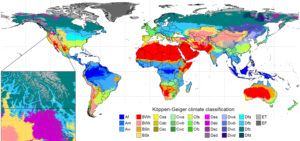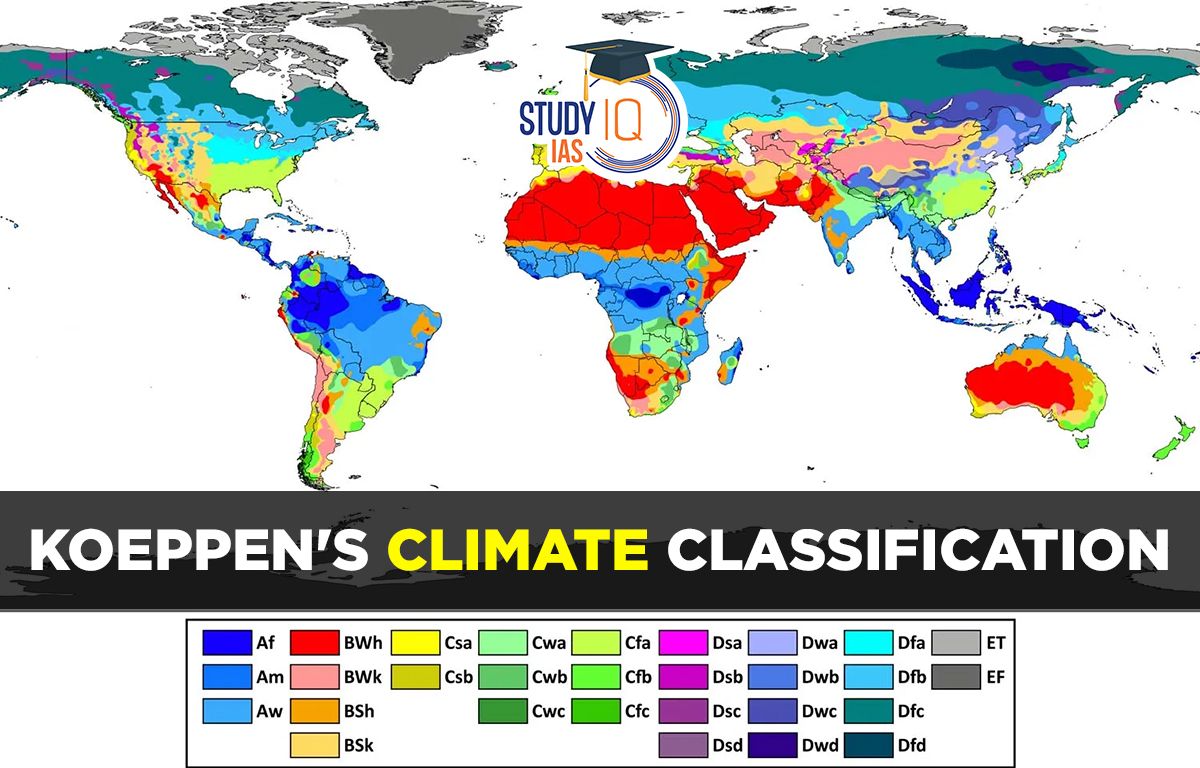Table of Contents
Koeppen’s Climate Classification
The climatic classification by Koeppen is the most widely used. It is based on temperature, precipitation, and seasonal characteristics. The relationship of climate with vegetation is also included with it. The world has been divided into five climatic groups according to this scheme. Four of them are temperature-based, and one is precipitation-based. A capital letter represents each type:
- A – Tropical Moist Climates: Average temperatures in all months exceed 18° Celsius.
- B – Dry Climates: with deficient precipitation during most of the year.
- C – Moist Mid-latitude Climates with Mild Winters.
- D – Moist Mid-Latitude Climates with Cold Winters.
- E – Polar Climates: extremely cold winters and summers.
The seasons of dryness are indicated by the small letters: f, m, w, and s.
- f -No dry season
- m – Monsoon climate
- w- Winter dry season
- s – Summer dry season
The small letters a, b, c, and d refer to the degree of severity of temperature.
Read More: Climatology
Koeppen Climate Classification Types
Here is a complete Koeppen’s Climate Classification given below:
| Group | Type | Letter Code | Characteristics |
| A-Tropical Humid
Climate
|
Tropical wet
Tropical monsoon Tropical wet and dry |
Af
Am Aw |
No dry season
Monsoonal, short dry season Winter dry season |
| B-Dry Climate | Subtropical steppe
Subtropical desert Mid-latitude steppe Mid-latitude desert |
BSh
BWh BSk BWk |
Low-latitude semi-arid or dry
Low-latitude arid or dry Mid-latitude semi-arid or dry Mid-latitude arid or dry |
| C-Warm
temperate(Mid Latitude) Climates |
Humid subtropical
Mediterranean Marine west coast |
Cfa
Cs Cfb |
No dry season, warm summer
Dry hot summer No dry season, warm and cool summer |
| D-Cold Snow forest
Climates
|
Humid continental
Subarctic |
Df
Dw |
No dry season, severe winter
Winter dry and very severe. |
| E-Cold Climates | Tundra
Polar ice cap |
ET
EF |
No true summer
Perennial ice |
| H-Highland | Highland | H | Highland with snow cover |
Read More: Equatorial Climate Region
Koeppen’s Climate Classification Map
The Köppen climate classification categorises climates into five major groups, with each group subdivided based on seasonal precipitation and temperature patterns.
- A (tropical),
- B (arid),
- C (temperate),
- D (continental), and
- E are the five major groups (polar). A letter represents each group and subgroup.

Read More: Tropical Climate
Group A: Tropical Humid Climates
Tropical humid climates can be found between the Tropics of Cancer and Capricorn. The sun shines vertically in this region all year. The Inter-Tropical Convergence Zone (ITCZ) is also present, making the climate of the region hot and humid. This region witnesses a low range of annual temperature and high annual rainfall. Tropical climates are classified into three types:
- Af- Tropical wet climate;
- Am- Tropical monsoon climate; and
- Aw- Tropical wet and dry climate.
1. Tropical Wet Climate (Af)
Near the equator, the tropical wet climate is common, found mainly in the Amazon Basin, western equatorial Africa, and the East Indies. Rainfall is steady throughout the year, and temperatures are consistently high with little variation. Rainfall is mostly convectional, happening daily in the afternoon. This area features tropical evergreen forests with dense canopies and rich biodiversity.
2. Tropical Monsoon Climate (Am)
In this climate region, the usual winds change direction. Tropical monsoon conditions are seen in the Indian subcontinent, northern Australia, and northeastern South America. This area gets rain during the summer, while winter is mostly dry.
3. Tropical Wet and Dry Climate (Aw)
The tropical wet and dry climate is found just north and south of the tropical wet climate areas. This type (Aw) can be seen near the Amazon rainforest in Brazil, parts of Bolivia and Paraguay, Sudan, and southern Central Africa. In this region, annual rainfall is much lower and varies more than in tropical wet areas. There is a longer dry season and a shorter wet season, with severe droughts. Temperatures are high year-round, with the biggest temperature changes happening during the dry season. This climate is marked by deciduous forests and grasslands with scattered trees.
Group B: Dry Climate
In this climatic region, rainfall is not enough to support the growth of plants. These climate regions cover a large part of the Earth, from 15° to 60° north and south of the equator. In the middle latitudes, between 35° and 60°, they are mostly found in the interiors of continents, where moist ocean winds can’t reach and are often surrounded by mountains.
Subtropical Steppe (BSh) and Subtropical Desert (BWh) Climates
Both climates share similar temperature and rainfall patterns. The subtropical steppe lies between humid and dry areas, receiving slightly more rain than deserts, which allows for sparse grasslands. Rainfall can be very variable, leading to famines in steppe regions. Coastal deserts often have fog where cold ocean currents meet. These climates are classified as middle latitude cold steppe (BSk) and middle latitude cold desert (BWk).
Read More: Anticyclones
Group C: Warm Temperate Climates
Warm temperate (mid-latitude) climates extend from 30° – 50° of latitude, mainly in the eastern and western margins of continents.
1. Humid Subtropical Climate (Cwa)
This climate is found north of the Tropic of Cancer and south of the Tropic of Capricorn, mainly in the North Indian plains and the interior plains of South China. It is similar to a tropical wet and dry climate, but winter temperatures are warm.
2. Mediterranean Climate (Cs)
Mediterranean climate occurs around the Mediterranean sea, along with the west coast of continents in subtropical latitudes between 30° – 40° latitudes. e.g. Central California, Central Chile, along the coast of southeastern and southwestern Australia. Here, the climate is characterized by hot, dry summer and mild, rainy winter.
3. Humid Subtropical Climate (Cfa)
The humid subtropical climate lies on the eastern parts of the continent in subtropical latitudes. Frontal rainfall occurs due to unstable air masses. They occur in the eastern United States of America, southern and eastern China, southern Japan, northeastern Argentina, coastal South Africa, and the eastern coast of Australia.
4. Marine West Coast Climate (Cfb)
The west coast climate of the continents is located poleward from the Mediterranean climate. The temperature is comparatively warmer in these regions due to the moderating effects of the sea. The main areas of Cfb are coastal regions of North America, north of California, Southern Chile, Southern Australia, and New Zealand. The average temperature in summer is 15°-20°C, and in winter average temperature is 4°-10℃. Precipitation varies from 50-250cm.
Read More: Steppe Climate
Group D- Cold Climate with Dry Winters (Dw)
Occurs mainly over Northeastern Asia. Monsoon-like reversal of wind occurs in this region, i.e., anticyclonic conditions develop in winter and weaken during summer. The annual precipitation is around 12-15cm.
Read More: Desert Climate
Group E: Polar Climates
It exists from 70° latitudes toward the pole. A polar climate consists of cool summers, and very cold winters, which results in treeless tundra, glaciers, or a permanent or semi-permanent layer of ice.
1. Tundra Climate (ET)
Tundras are one of the coldest, and harshest biomes in the world. Tundras are found in the Arctic region and on top of mountains. These are treeless areas with strong winds and very little rain. The soil is permanently frozen and is called permafrost.
2. Ice Cap Climate (EF)
Here temperature does not exceed 0℃, even in summer. This area receives very little rainfall. This climatic region occurs over the interior of Greenland and Antarctica.
3. Highland Climates (H)
This climate is found in high mountain areas. This climate is found on single mountains like Mount Kilimanjaro and large high areas like the Plateau of Tibet. In high mountains, temperatures can change quickly over short distances, and the type and amount of rainfall also vary greatly.
Read More: Savanna Climate
Koeppen’s Climate Classification UPSC
The Köppen climate classification system classifies climate zones around the world based on local vegetation. Wladimir Köppen, a German botanist and climatologist, created this system at the end of the nineteenth century, basing it on earlier biome research. This article discusses Koeppen’s Climate Classification System. Geography is an important aspect of the IAS exam.
Read More: Siberian Type Climate


 Story of Meera Bai and Her Devotion For ...
Story of Meera Bai and Her Devotion For ...
 Desert Climate, Distribution, Climatic C...
Desert Climate, Distribution, Climatic C...
 Deserts of India Map, Features of Thar D...
Deserts of India Map, Features of Thar D...





















